|
A few years ago, Smith & Wesson
beefed up their handy little J-frame stainless .38 Special Model
60 revolver a bit to enable it to fire the .357 magnum
cartridge. That subtle change made a good little pocket gun even
better. The Model 60 has been popular since its introduction
into the S&W line many years ago. For a long time, the
little stainless gun sold for a premium, bringing much more
money than suggested retail. It was for many years the standard
by which all other small revolvers were measured. Through the
years, it has been offered in several variations, with different
barrel lengths, grips, and sights.
About six weeks ago, I was speaking on the
telephone with an executive at Smith & Wesson when he
mentioned to me the newest variation of the Model 60. He said
that they were about to produce that little gun with a five-inch
barrel. As the title of this piece suggests, I immediately
thought "Kit Gun". While S&W makes no mention of
the name "Kit Gun" in their promotion of this little
Model 60, it was the first thought to enter my mind, and ever
since, that is what I believe to be the true destiny of this
little five-inch revolver.
For those who have no idea of the concept of a
Kit Gun, I will attempt an explanation here, if for no other
reason than to head off several emails regarding the term. The
term "Kit Gun" came into being many decades ago, and
loosely describes a handy little firearm made to be carried in a
fishing tackle box, knap sack, back pack, or any other
outdoorsman’s kit. For years, S&W marketed some fine
little .22 rimfire revolvers such as their models 34, 43, 63,
and 651, among others, as Kit Guns. While other firms have
offered kit guns, the name "Kit Gun" to me has always
brought to mind the small framed, adjustable sighted, four-inch
barreled Smith & Wesson twenty-twos. My personal favorite
for many years has been a dandy little Model
63 stainless J-frame four-inch twenty-two; a gun which
is dear to my heart. While a kit gun could be used for a number
of reasons, one prerequisite for me is that a kit gun must be
accurate. It also must be of a size that is, while
shootable, handy enough to be carried unobtrusively while doing
other chores. A kit gun is the sidearm that you have along while
engaged in other projects, such as hiking, camping, fishing,
hunting, or any number of other outdoor activities. It is an
"always gun" to be along for the ride anytime one is
enjoying the great outdoors. It serves for plinking, protection,
and to fill the pot with whatever game presents itself. I
often carry my Model 63 when big game hunting while packing a
center fire rifle. The little gun is light enough and
compact enough to be out of the way, but is there if needed to
finish an animal or to dispatch a gray squirrel or ornery
copperhead.
Sometimes, a squirrel or poisonous snake might
not be the only things for which a kit gun is needed. Sometimes,
more power is called for, and that is where the Model 60 .357
comes into play. Having five shots of .357 magnum power
available is a lot better than six shots of .22 Long Rifle. Five
shots of .357 magnum can also be a lot better than a larger,
more powerful sixgun that you left back on the riverbank or in
the pickup truck because it was just too heavy and bulky to
carry comfortably on your hip. The Model 60 is for all practical
purposes the same size and weight as the Model 63. It is slim
enough and light enough to be always at your side. Whether
fishing in bear country, hiking in areas where big cats or wild
dogs are present, or camping in remote areas where your only
backup is your sidearm, a good .357 magnum can answer the call
when a less powerful cartridge might not. Now so that there is
no misunderstanding, I am not advocating hunting grizzlies with
a .357 handgun. However, five shots of 180 grain hard cast lead
is much better than beating seven hundred pounds of angry bear
with a fly rod.
Anyway, after opening the box containing the new
five-inch Model 60, I knew right away that this little five-shot
revolver just might be the sidearm to displace my beloved Model
63 as the gun that is most often on my hip when I am rambling
through the woods, if it proved to be as accurate as I hoped
that it would be.
The new Model 60 is built almost entirely of stainless steel,
and incorporates Smith & Wesson’s newest changes to their
revolver line, such as an internal key lock and a two-piece
barrel/shroud system. The five chambers have a very slight
chamfer to the mouths , and the extractor star is shaped to fit
its recess without the use of alignment pins. The ejector rod
has a longer throw than on most Model 60s to help quickly eject
spent cases. The round butt grip is fitted with some very
attractive rosewood finger-groove grip panels. While the trigger
is left smooth for quick double action work, the hammer and
cylinder release are checkered for secure, non-slip activation.
The sample gun had a smooth double-action trigger pull weighing
nine pounds and three ounces, and a crisp single action pull of
three pounds and six ounces. The barrel/cylinder gap
measured .007 inch, which is a bit larger than I like, but
entirely serviceable. The sights consist of the excellent
S&W adjustable unit rear and a red insert on the pinned-in
blued front blade. I prefer a plain black front sight, but this
one is easily changed. I had to have the red ramp sight on my
old Model 63 milled off and a black blade installed by David
Clements (www.clementscustomguns.com)
The sight blade on this Model 60 can thankfully be replaced at
home. The barrel on the Model 60 has a two-thirds underlug that
protects the ejector rod, while not adding too much weight to
the barrel. The weight of the five-inch Model 60 is a handy 25.8
ounces; only two tenths of an ounce more than my Model 63 with a
four-inch barrel.
While I found the slim rosewood grip panels to
be quite attractive, I have a large hand, and needed a bit
larger grip to comfortably control this svelte little gun. I
bolted on a set of synthetic rubber laser grips from Crimson
Trace, which fit my hand much better. More on these grips a
little later.
For shooting the little magnum, I gathered a
variety of ammunition and proceeded with velocity and accuracy
tests. Velocities were recorded over the electronic eyes of my PACT
chronograph at a distance of ten feet, with an air temperature
of fifty-nine degrees. Velocity is listed for all loads in
feet-per-second as follows:
| LOAD |
VELOCITY (FPS) |
| Handload # 9 Lead Shot in Speer Capsule |
1005 |
| Federal 158 Grain Jacketed Hollowpoint |
1284 |
| Handload 125 Grain Jacketed Hollowpoint |
1380 |
| Handload 162 grain Semi-Wadcutter (Keith) |
1095 |
| Handload .38 Special 162 Grain Keith |
819 |
| Cor-Bon .38 +P 110 Jacketed Hollowpoint |
1294 |
| Cor-Bon .38 +P 125 Grain jacketed
Hollowpoint |
1162 |
| Cor-Bon .357 110 Grain jacketed
Hollowpoint |
1497 |
| Cor-Bon .357 140 Grain Jacketed
Hollowpoint |
1283 |
| Cor-Bon .357 180 Grain Soft Point |
1186 |
| Cor-Bon PowRBall 100 Grain |
1691 |
| Glaser Silver Pre-fragmented Bullet |
1710 |
| Glaser Blue Pre-fragmented Bullet |
1770 |
| Black Hills 158 Grain Jacketed Hollowpoint |
1084 |
| Buffalo Bore 125 grain jacketed
Hollowpoint |
1549 |
| Buffalo Bore 158 Grain Jacketed
Hollowpoint |
1410 |
| Buffalo Bore 170 Grain Jacketed
Hollowpoint |
1371 |
| Buffalo Bore 180 Grain Lead Flat Nose Gas
Check |
1313 |
| Grizzly Cartridge 180 Grain Wide Flat Nose
Gas Check |
1127 |
Depending upon the situation, there is not
likely any handgun need that cannot be filled by one or more of
the loads listed above. The Model 60 functioned flawlessly
with all loads tested. Extraction was easy with each load tried,
with the exception of the Cor-Bon 140 grain JHP load, which gave
sticky extraction. With most of the loads listed, recoil was
brisk in the lightweight revolver, but not at all painful. The
Model 60 Kit Gun has an excellent balance of weight and power.
It is easier to shoot well than the super-light titanium
revolvers that I have tried, but still weighs about a pound less
than a full size .357 magnum such as a Smith & Wesson Model
686 or Ruger GP100. It even weighs almost a pound less
than my other favorite five-shot .357 magnum, an old Flattop
Ruger Blackhawk. Weight is not the only advantage that
the Model 60 has over these other sidearms; bulk is much less
with the little S&W. I spent a great deal of time recently
wearing the little Model 60 on my side in a Bob Mernickle
FC3 cross draw holster. This is a superb holster for field
carry. It carries the handgun in a position that is very
comfortable while sitting on an ATV or tractor, and should work
just as well while riding a horse. The gun rides in an almost
horizontal position that doesn’t poke the ribs while seated,
and keeps the weapon out of the way of a slung rifle or
backpack. The thumb break design keeps the gun holstered
regardless of activity, yet allows instant access should the
need arise. The holster is extremely well built, and fits the
gun perfectly. I have used the FC3 for a Ruger
Single Six Hunter previously, and the decision to get
one for the Model 60 proved to be an excellent choice.
I was also very pleased with the accuracy of the
Model 60 Kit Gun. It would group most loads within two inches at
twenty-five yards, and did much better with its favorite
ammunition. The best groups fired were with a handload using a
162 grain Keith bullet at just under 1100 fps. This load would
group under one inch at twenty-five yards, and I was trying hard
too keep that red front sight in focus with my aging eyes.
After dark, I tried the Model 60 on a man-sized
silhouette target at a distance of twenty-five yards using the Crimson
Trace laser grip sight. For several years, I was opposed to
these laser type sights on handguns, but the Crimson Trace unit
is unobtrusive, and very useful. I have had to change my
position on these little devices. It was much too dark to see
the sights on the Model 60, but the silhouette target could be
easily seen in the dim moonlight. It was positioned in the
woods, with enough light reaching the target to make it visible
from that distance. Placing the laser dot on the torso of the
target, I fired off five quick double-action shots, reloaded,
and fired five more quick shots into the head of the silhouette.
In the pictures, you can tell that it was very dark outside, but
the hits were accurate, quick, and easy. I am a believer in the
Crimson Trace laser grip! Late at night in a dark lonely
campsite, the little Model 60 with the CT laser grip would be a
very valuable asset to have at your side should a stranger with
ill intentions come calling. For those who do not need a larger
grip as I do, Crimson Trace makes a smaller version of the same
grip. These grips are available directly from Crimson Trace,
Smith & Wesson, and many other retailers. They fit the gun
very well, are easily sighted in, and extra batteries are
commonly available most anywhere that batteries are sold.
Perhaps it was a little presumptuous of me
declaring this little Model 60 to be a Kit Gun. It is also a
very accurate handgun for informal target shooting and plinking.
It has plenty of accuracy and ample power for deer hunting
within handgun range. It would certainly make for a good bedside
gun, particularly with the Crimson Trace grips. It would also be
an excellent concealed carry revolver properly holstered, having
much less bulk and weight than a larger framed .357, while
possessing more power and better shootability than a snub nosed
revolver. To me however, the five-inch Model 60 is the ideal Kit
Gun; the sidearm of the outdoorsman, the gun that is always at
his side no matter what the activity, be it hunting, fishing,
cutting firewood, hiking, or just bumming around in the woods or
desert. In this five inch Model 60, I just might have found a
sidearm that will travel with me more than my old Model 63 Kit
Gun. It’s a keeper.
Check out the entire line of pistols, revolvers,
and accessories from Smith & Wesson online at: www.smith-wesson.com.
For more information on the Crimson Trace laser
grips, go to; www.crimsontrace.com.
For custom holsters expertly crafted to fit just
about any handgun, check out the line of leather at:
www.mernickleholsters.com.
For more info on the quality ammunition listed
above, go to: www.buffalobore.com,
www.grizzlycartridge.com,
www.black-hills.com,
and www.cor-bon.com.
Jeff Quinn
  
Got something to say about this article? Want to agree (or
disagree) with it? Click the following link to go to the GUNBlast Feedback Page.
|
|
Click pictures for a larger version.

Smith & Wesson Model 60 .357 Magnum Five Inch "Kit
Gun".
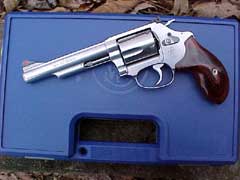
S&W's 5" Model 60 comes with a lockable hard
plastic case.
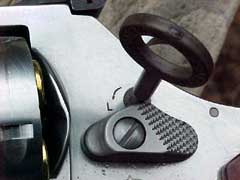
The 5" Model 60 features S&W's well-designed
and easy-to-ignore key lock system.
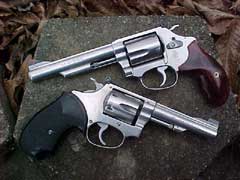
The 5" Model 60 (top) compares favorably in every
way with Jeff's beloved Model 63 .22 "Kit Gun"
(bottom), with the added benefit of .357 Magnum power.
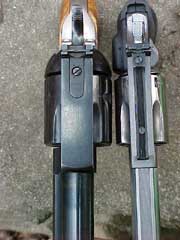
One of Jeff's favorite "five-shot" .357s, the
Ruger .357 Blackhawk "Flattop" (left) dwarfs the
handy S&W 5" Model 60 (right).
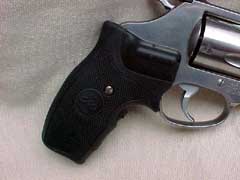
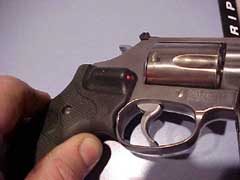
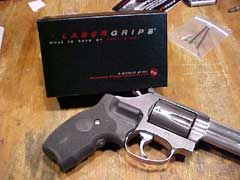
The 5" Model 60 comes with a very nice set of
round-butt grips, but they proved to be a bit small for Jeff's
hand. Installing a set of Crimson Trace laser grips solved
this, and added the benefit of an unobtrusive night-sight
system.

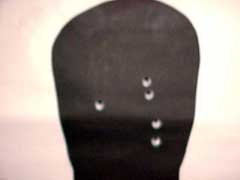
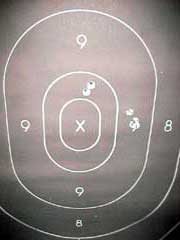
The Crimson Trace laser grips proved to be quick and
easy to use. Long a skeptic of such sights, Jeff is now a
believer!
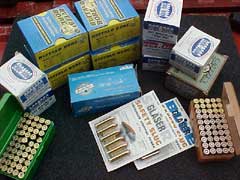
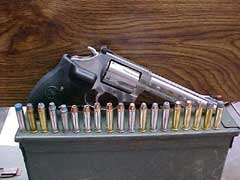
Jeff tested the Model 60 with a wide variety of
handloads and factory loads.

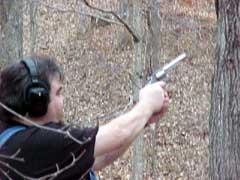
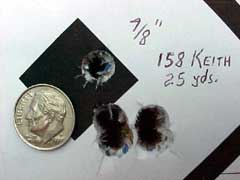
Both author Jeff (top) and webmaster Boge (bottom) found
the Model 60 to be very easy to shoot, and shoot well.
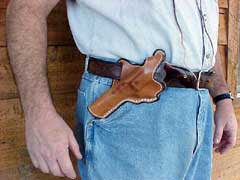
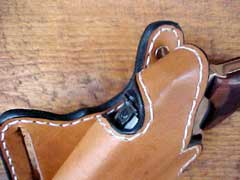
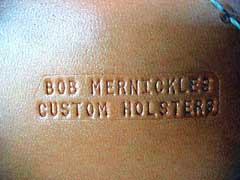


Bob Mernickle has become one of Jeff's favorite holster
makers, and Mernickle's FC3 Extreme Crossdraw holster proved
to be the perfect carry option for S&W's great little
Model 60.
|
![]()